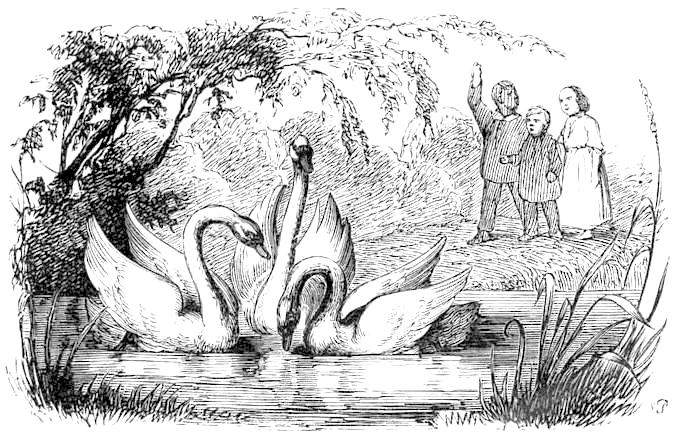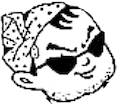Is "The Ugly Duckling" really a
story of salvation?

Is "The Ugly Duckling" really a
story of salvation?

ここで検討したいのはアンデルセン( Hans Christian Andersen, 1905-1875)の童話『みにくいアヒルの子』("The Ugly Duckling")は、本当に救済の物語なのかという「解釈」の問題である。まず、ウィキペディアの解説からである。
| Den grimme ælling |
I eventyret
følges en svaneunge, der klækkes i en andegård ved en herregård. I
første del af historien ved hverken svaneungen selv eller de omgivende
dyr, at den ikke er en and, og på grund af dens anderledes udseendende
behandles svaneungen dårligt. Nogle ænder siger "ham [svaneungen] ville
vi ikke tåle", at "han er for stor og for aparte", "så skal han nøfles"
og andre omtaler svaneungen som "inderlig styg" og "fæle spektakel".
Svaneungen bliver bidt, puffet, gjort nar af, hugget og sparket af
eventyrets forskellige figurer. Først til sidst i eventyret afslører
H.C. Andersen, at "den grimme ælling" er en svaneunge. Det sker hvor
svaneungen selv opdager sin egen identitet, da den nærmer sig nogle
andre svaner og tror den vil blive dræbt. Den bøjer hovedet og ser sit
eget spejlbillede. |
| The Ugly Duckling |
When the story
begins, a mother duck's eggs hatch. One of the little birds is
perceived by the other birds and animals on the farm as an ugly little
creature and suffers much verbal and physical abuse from them. He
wanders sadly from the barnyard and lives with wild ducks and geese
until hunters slaughter the flocks. He finds a home with an old woman,
but her cat and hen tease and taunt him mercilessly and once again he
sets off alone. The duckling sees a flock of migrating wild swans. He is delighted and excited, but he cannot join them, for he is too young and cannot fly. Winter arrives. A farmer finds and carries the freezing little duckling home, but the foundling is frightened by the farmer's noisy children and flees the house. He spends a miserable winter alone in the outdoors, mostly hiding in a cave on the lake that partly freezes over. When spring arrives, a flock of swans descends on the lake. The ugly duckling, now having fully grown and matured, is unable to endure a life of solitude and hardship any more and decides to throw himself at the flock of swans deciding that it is better to be killed by such beautiful birds than to live a life of ugliness and misery. He is shocked when the swans welcome and accept him, only to realize by looking at his reflection in the water that he had been, not a duckling, but a swan all this time. The flock takes to the air, and the now beautiful swan spreads his gorgeous large wings and takes flight with the rest of his new family. |
| みにくいアヒルの子 |
アヒルの群の中で、他アヒルと異なった
姿のひなが生まれた。アヒルの親は、七面鳥のひなかもしれないと思う。周りのアヒルから、あまりに辛く当たられることに耐えられなくなったひな鳥は家族の
元から逃げ出すが、他の群れでもやはり醜いといじめられながら一冬を過ごす。生きることに疲れ切ったひな鳥は、殺してもらおうと白鳥の住む水地に行く。し
かし、白鳥たちの意外な反応にひな鳥は水面に映る自分の姿を見る。いつの間にか大人になっていたひな鳥は、自分がアヒルではなく美しい白鳥であったことに
気付くと、それまでの悲しみから解放される。 |
●倫理的検討(項目:プレイヤー)
1)白鳥の生まれだったあひるの養子
2)白鳥の子ども(雛)を受け入れた義母のアヒル
3)「みにくいアヒルの子」をいぢめた兄弟たち
4)成長した「みにくいアヒルの子」を受け入れた同胞の白鳥たち
●倫理的検討(審問)
1)白鳥の生まれだったあひるの養子
なぜ自分が他の子と違うように感じたか?
それに対して、自分はどのような生き方を選択しようと考えたのか?
結果的に白鳥に受け入れられてメデタシ・メデタシとなったが、最初の動機は自殺企図である。結果(=自分が白鳥であることを他の白鳥から「承認」される)がオーライだからといって、白鳥のところに「殺されるために」赴くことは倫理的に許されるのか?
大きくなって白鳥の雌鳥となった時に、性的興奮を覚えず、アヒルの雌鳥に情欲を覚える時、異種感の性的倫理の責はだれにあると考えるのか?
2)白鳥の子ども(雛)を受け入れた義母のアヒル
雛を受け入れるときに産みの親との契約は交わしたのか?
捨て子の場合、どのような経緯で受け入れたのか?
自分が、白鳥の子どもを受け入れた時に、その成長の過程で、みにくいアヒルの子の命運を予測できたのか?
どのようにして雛を受け入れるようになったのか、みにくいアヒルの子が、成長した時にどのような心理的影響を顧慮したか?
3)「みにくいアヒルの子」をいぢめた兄弟たち
なぜ「みにくいアヒルの子」をいぢめたのか?
いぢめの理由を自分で分析できるのか?またその過去における責任をどのように引き受けるのか?
かつての兄弟が、白鳥になり「みにくいアヒルの子」から、肉体的復讐を受ける時に、それを受け入れるのか?
自分の過去の責任に対して、白鳥になった「みにくいアヒルの子」を自らを守る権利を有するのか?それを正当化する論理や道徳的原則とはなにか?
4)成長した「みにくいアヒルの子」を受け入れた同胞の白鳥たち
姿形は白鳥だが、アヒルのあいだで育った同胞が異なった振る舞いをするときに、彼の行動や価値観を受け入れる用意はあるのか?
自らの同胞が得た、この辛酸を嘗める経験を、どのようにして自分たちの道徳律に包摂するができるのか?
●倫理的教訓的物語論として「みにくいアヒルの子」について
こ のページの表題にあるように「みにくいアヒルの子 は本当に救済の物語なのか?」という審問についても考えなければなりません。アヒルの生活をみにつけ、ようやく、アヒルらしく生きることを断念し、自殺と もいえる白鳥世界に飛び込んだ時に、いままで異質な他者だと思っていた白鳥に受容される。これこそアイデンティティの危機の到来です。アヒルの生活から離 脱する決断は、アヒルらしく生きることを放棄した後なので、この「みにくいアヒルの子」は、一度死に、白鳥として生まれ変わったという物語として受け入れ られることができます。この物語の、倫理的問題は「自分が絶望したら死ぬことは権利」として容認されていることを暗示していることです。そのために、自ら の醜さのためにこれまで死んでいった、われわれすべての、いぢめの犠牲者の死を「ありえることと」受け入れることで、「いぢめは絶対いけないという倫理」 を断念することにつながります。したがって、この物語を、自分の醜さ、理由もなくいじめをうけている子どもに見せることは、不要な感情的動揺を与えること になり、また、無自覚にいじめ(いぢめ)を実践している連中には、何の反省も与えることができません。いぢめられた「みにくいアヒルの子」が仲間の白鳥を 引き連れてリベンジするのも、個人的怨恨を禁止している近代社会の法道徳から容認することができません。なによりも困ったことに、異種間の紛争問題を解決 する法廷も、裁判外紛争解決の手段もないということです。
クレジット:みにくいアヒルの子 は本当に救済の物語なのか?あるいは「みにくいアヒルの子」の道徳動物学について
リンク
文献
その他の情報
Copyleft, CC, Mitzub'ixi Quq Chi'j, 1997-2099
